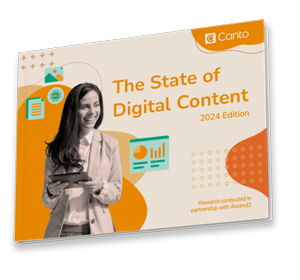Top 8 ways to easily refresh your content library
| September 15, 2022

What is a content refresh?
A content refresh is the addition of new copy, branding, assets, or other SEO-related activities in order to make content more relevant, on-brand, or fulfill new marketing campaign initiatives. Marketing teams may decide to refresh content when it is no longer performing as expected on their site, in email campaigns, or through organic and direct traffic.
As content ages, content decay — the process of content becoming inaccurate (or less accurate) —sets in. Even evergreen content cannot stay on-brand and relevant forever and requires refresh over time.
It is important to update or refresh content in order to:
- Own specific core business keywords on organic search in order to keep or gain market share from competitors.
- Increase brand equity and trust by creating an on-brand content journey across all channels, no matter where a visitor or customer may interact with your brand.
- Improve conversion metrics for marketing campaigns and other specific tactics.
- Include new products, integrations, or features in existing assets.
Marketing teams may choose to perform a content refresh periodically, such as on an annual basis or during a content audit. Branding initiatives, marketing campaign requirements, and search engine optimization tactics should drive how often you look to refresh content that is in decay, among other factors.
But how do you know where to start in your content refresh journey?
Laying the foundation for a content refresh
Before you get started on refreshing content, you should lay some groundwork for your marketing planning (if you haven’t already). These two foundational steps assuredly will make the tips below easy to execute.
Perform a Content Audit
A content audit is the process of cataloging or indexing your content into an easy-to-digest format. What content is performing well? What’s out of date? Is anything off-brand? Performing a content audit will help your team understand where they stand today in terms of content resources at your disposal (and what is missing).
Using a digital asset management platform makes content audits easier, because all your brand’s content is already in one place.
Use a Content Strategy
A content strategy guides the tactical direction of your marketing team’s initiatives and should be central to your marketing arsenal. In your marketing strategy, your team should define:
- Which audiences, verticals, or markets are key to your business to target.
- What personas your organization should be targeting.
- What content is the most important to create or refresh.
Think of your content strategy as the tactical activities your marketing department is taking to achieve your organization’s vision.
Once you have those two pieces in place, you can easily transition to these 8 tips to refresh content quickly.

8 ways to perform a content refresh today
There are ways your marketing team can refresh content to make an impact in a short time. Let’s look at 8 fireproof, easy ways you can get started on a content refresh today.
1. How to handle rebranding
Many organizations will go through a rebranding process at some point, which can cause content decay to set in and make even the most important and high-performing assets off-brand quickly. Even brands that don’t choose to rebrand will evolve over time and require rebranding at some point. Finding quick ways to catalog off-brand assets and refresh them using new color palettes, logos, typography, and on-brand copy is key.
Pro Tip: Tools such as Canva, which integrates directly with your Canto Library, enable your team to add new color gradients and on-brand assets quickly. Using Adobe InDesign? Canto integrates with that too.
2. Scale content while keeping your brand voice
Brand guidelines dictate your brand’s visual and verbal style, such as color palettes and typography (which we briefly discussed above). Basically, your brand guidelines communicate who your brand is to the world. And part of your identity is your brand voice, which is the distinct sound and personality your brand chooses to use in your messaging.
Invariably, many brands utilize multiple team members or collaborate with creative agencies and freelancers, which makes keeping your tone and voice on-brand extremely difficult as you scale content efforts. The way to ensure that everything stays on-brand with consistent messaging and look across channels? Branding guidelines, of course!
Pro Tip: You need to have brand guidelines established, communicated, and in a location that is easy to find. With Canto, you can create, edit, store, and distribute your brand guidelines easily and securely to internal and external teams.
3. Add new products or integrations
As your organization grows, your product line will change, gain integrations and extensions, and include add-ons for customers. And while the long-term goal should always be to refresh content to include your new products in relevant one pagers, guides, eBooks, and other relevant sales collateral (using your content audit to guide these efforts), that will take time.
In the meantime, shorter term updates can make a big impact too.
Create custom product banners in appropriates sizes (on-brand, of course) and sprinkle those banners throughout your marketing campaigns and assets. Consider using banners:
- As in-line call-to-actions within relevant blog posts.
- Within customer newsletters to increase upsells.
- Within nurture sequences to raise awareness of new products and integrations.
- Within sales outreach sequences or on sales email signatures.
This way, you don’t need to perform a full content refresh immediately in order to increase product page traffic and visibility upon launch. That’s called scaling content on a budget.
4. Refresh page metadata
Optimizing metadata, which is the data used to organize other data to be more meaningful, can be one of the easiest and fastest ways to improve site content such as older blog posts. Consider the following hierarchy for SEO refresh:
- Meta titles (also known as title tags or SEO titles) should be first to refresh. These are the first things that should be optimized for search engines. Try including your primary keyword, actionable word choices to entice clicks, and your brand name included at the end of the tag.
- Meta descriptions should include both primary and secondary keywords. Ensure you capture the intent of the article in your copy while staying on-brand and relevant.
- Headlines should also include your primary keyword and secondary keywords if possible, and can be similar to the title tag if you choose.
Pro Tip: Try optimizing using one tactic at a time and then measuring results, otherwise you won’t uncover which tactic led to an increase or decrease in traffic or ranking.
5. Add new copy
All assets have a shelf life, even evergreen content. Eventually, you will need to refresh the copy of your landing pages, blog posts, and long-form content as your brand, products, audiences, or business focus shifts. Use a content audit to know which content is performing best and which is in dire need of improvement from decay.
Try the following as you look at what copy you need to add to aging content to improve shelf life:
- Focus on ensuring the new and refreshed copy is on-brand and industry-relevant as you look to showcase your brand as a thought leader in a specific space or topic.
- Ensure your blogs that are not performing on search get the keyword research they need in order to refocus on the right primary and supporting keywords that are relevant today.
Pro Tip: Try combining steps four and five for the best SEO results on blogs, landing pages, pillar pages, and even product pages.
6. Include relevant interlinks
Add interlinks (links to other important pages on your site) onto landing pages in campaigns, eBooks, and more in order to allow search engines to crawl your site more extensively. For example, as you publish an eBook on a specific topic, you can find all related content on that subject and add links within that content to the new eBook. Think of this as building a spider web that connects your pages together.
Pro Tip: Anchor text, or the text your hyperlink rests upon, should be on contextually-relevant copy as related to the destination link.
7. Augment content with new formats
For content that is stunning and performs well on search or CTR (or at least decently), consider adding or embedding new types of content into the original content medium, such as videos or infographics. New mediums will help audiences digest the content in new and meaningful ways and engage with visitors that are more inclined to skim your content for the most important tidbits.
Pro Tip: You don’t need to recreate the wheel when creating this new content; repurposing content into different mediums with tools like Canva or Adobe Photoshop + Canto is a breeze.
8. Retarget content for new audiences
Retargeting content, or taking existing content and slightly changing to fit for a new but similar audience/persona, is the easiest way to enter new markets and verticals. Creating a brand-new library of content around a specific vertical is a large lift and may not work with your budget requirements. But retailoring existing eBooks with new images and slight copy modifications? That’s a no brainer.
Pro Tip: With Canto’s version control, you can choose to keep all your eBook versions together vertically stacked or separate them out as different files entirely. Your choice.

Digital asset management makes refreshing content easier
Having a digital asset management platform at your disposal makes refreshing your old content easier than ever before. With all your content in one place as a single source of truth, content auditing and strategy becomes a cinch. You can focus your team’s efforts on refreshing your content to be on-brand, tailored to the audiences you desire, and performing better than ever before.
Download our eBook, “Scaling Digital Content Creation in Today’s Workplace,” for more ways to navigate today’s biggest content creation challenges and maximize the impact of your brand’s digital content.
